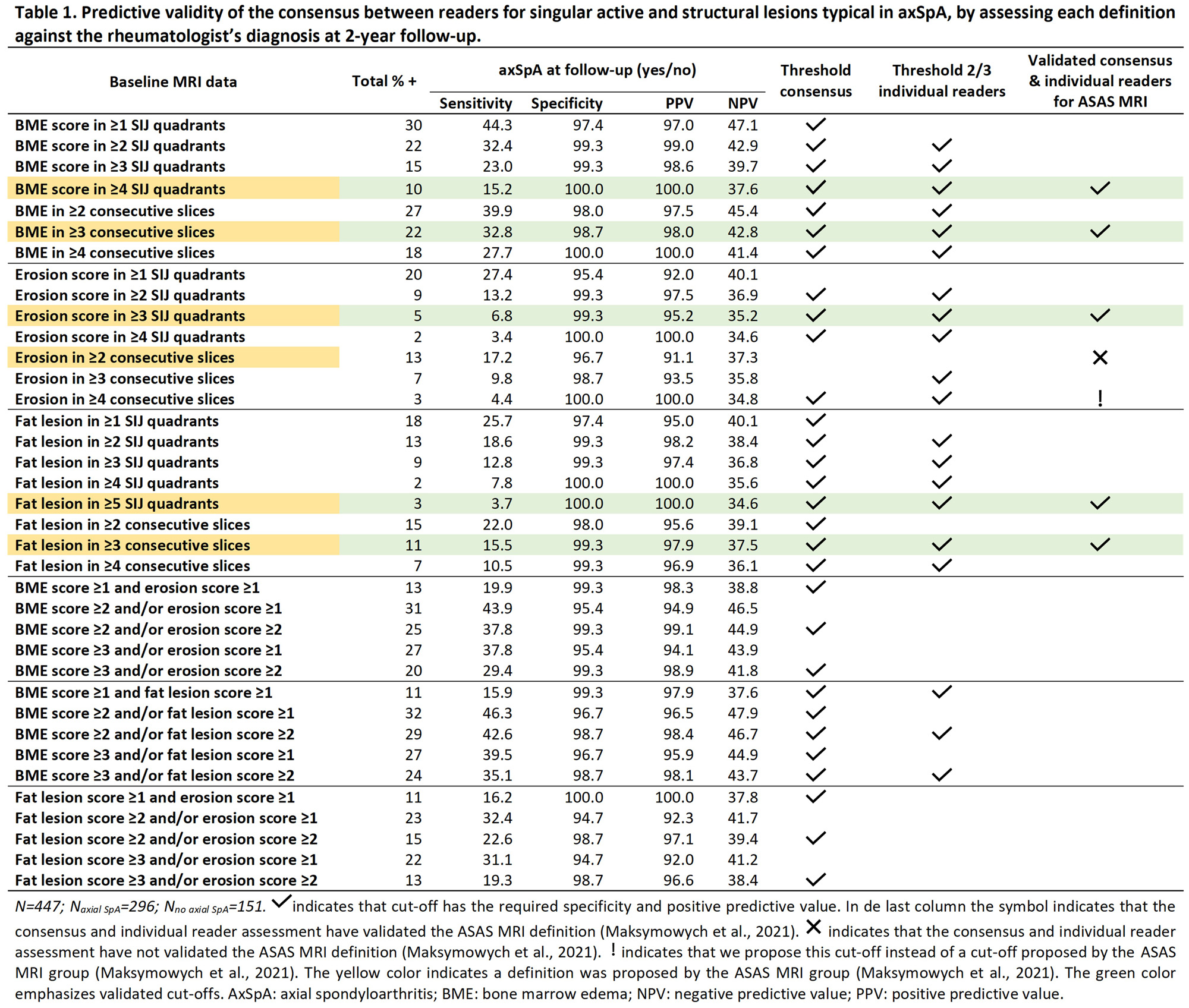Session Information
Session Type: Abstract Session
Session Time: 4:00PM-5:30PM
Background/Purpose: The Assessment of Spondyloarthritis international Society MRI (ASAS MRI) group has proposed definitions for active and structural lesions typical for axial SpA (axSpA) on SI joint MRI (MRI-SIJ), based on high specificity and positive predictive values (PPV; ≥95%) for the rheumatologist’s diagnosis of axSpA (Maksymowych et al., 2021). These cut-offs have not been validated in other cohorts nor assessed in early disease. Here, we analyze the predictive validity of the proposed cut-offs for active and structural MRI-SIJ lesions in early axSpA after 2 years follow-up.
Methods: Patients with chronic back pain (unknown origin; ≥3 months; ≤2 years; onset < 45 years) from the SpA Caught Early (SPACE) inception cohort were followed-up and diagnosed (axSpA/no axSpA) by a rheumatologist after 2 years (Marques et al., 2023). Three central readers scored baseline MRI-SIJ for bone marrow edema (BME), erosion, fat lesions, and sclerosis. Patients with a certain (level of confidence about the diagnosis ≥7) or very probable (level of confidence < 7 and a consistent diagnosis in the last 2 available visits) diagnosis were included for analysis. When data were available for ≥2 readers, the MRI SIJ were analyzed for consensus between ≥2 readers on scored lesions and each individual reader. The lesions were assessed for quadrants, consecutive slices, or combinations between different lesions (Table 1 & 2). We calculated sensitivity, specificity, PPV and negative predictive values (NPV) for each cut-off. Based on consensus, a combination of specificity ≥95% and PPV ≥95% was required for a cut-off to be considered validated. For the individual readers, a PPV of ≥94% in ≥2 readers was accepted.
Results: We analyzed 447 patients (age 30 (SD 8) years; 45% males; 66% axSpA). BME in ≥1 quadrant, or ≥2 consecutive slices met the threshold based on consensus (Table 1). BME in ≥2 quadrants or ≥2 consecutive slices met the threshold in ≥2 individual readers (Table 1 & 2). Erosions in ≥2 quadrants or ≥4 consecutive slices, and fat in ≥1 quadrant or ≥2 consecutive slices met the threshold based on consensus. Erosion in ≥3 consecutive slices met the threshold in ≥2 individual readers, and fat in ≥2 quadrants or ≥3 consecutive slices met the threshold in all individual readers. All combinations of BME-fat met the threshold based on consensus (Table 1). Combinations of BME-erosions and fat-erosion in ≥1 quadrants, each and/or one of both ≥2 quadrants, or ≥3 quadrants with fat lesions and/or ≥2 quadrants with erosion met the threshold based on consensus. Combined lesions did not outperform single item lesions.
Conclusion: In early axSpA, the proposed ASAS MRI cut-offs for active SIJ lesions have been validated in consensus and individual reading. For structural SIJ lesions, the proposed cut-offs for fat in quadrants and consecutive slices as well for erosions in quadrants have been confirmed. However, we propose a higher cut-off of ≥4 consecutive slices for erosions. All these cut-offs have now shown a high specificity and PPV in both early and established axSpA.
To cite this abstract in AMA style:
de Bruin L, marques M, Van Lunteren M, de Hooge M, Exarchou S, Van Gaalen F, van der Heijde D, Ramiro S. Predictive Validity of Data-driven Definitions for Active and Structural Lesions in the SI Joints Typical for Axial SpA: A 2-year Follow-up in the SPondyloArthritis Caught Early Cohort [abstract]. Arthritis Rheumatol. 2023; 75 (suppl 9). https://acrabstracts.org/abstract/predictive-validity-of-data-driven-definitions-for-active-and-structural-lesions-in-the-si-joints-typical-for-axial-spa-a-2-year-follow-up-in-the-spondyloarthritis-caught-early-cohort/. Accessed .« Back to ACR Convergence 2023
ACR Meeting Abstracts - https://acrabstracts.org/abstract/predictive-validity-of-data-driven-definitions-for-active-and-structural-lesions-in-the-si-joints-typical-for-axial-spa-a-2-year-follow-up-in-the-spondyloarthritis-caught-early-cohort/


